parking brake CHEVROLET OPTRA 5 2007 1.G Owners Manual
[x] Cancel search | Manufacturer: CHEVROLET, Model Year: 2007, Model line: OPTRA 5, Model: CHEVROLET OPTRA 5 2007 1.GPages: 422, PDF Size: 2.39 MB
Page 87 of 422
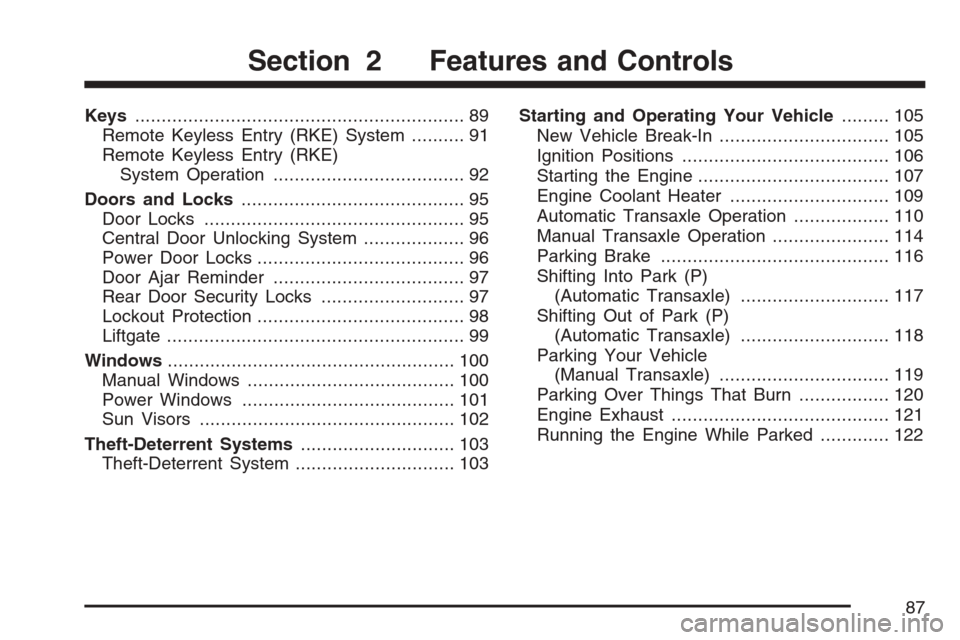
Keys.............................................................. 89
Remote Keyless Entry (RKE) System.......... 91
Remote Keyless Entry (RKE)
System Operation.................................... 92
Doors and Locks.......................................... 95
Door Locks................................................. 95
Central Door Unlocking System................... 96
Power Door Locks....................................... 96
Door Ajar Reminder.................................... 97
Rear Door Security Locks........................... 97
Lockout Protection....................................... 98
Liftgate........................................................ 99
Windows...................................................... 100
Manual Windows....................................... 100
Power Windows........................................ 101
Sun Visors................................................ 102
Theft-Deterrent Systems............................. 103
Theft-Deterrent System.............................. 103Starting and Operating Your Vehicle......... 105
New Vehicle Break-In................................ 105
Ignition Positions....................................... 106
Starting the Engine.................................... 107
Engine Coolant Heater.............................. 109
Automatic Transaxle Operation.................. 110
Manual Transaxle Operation...................... 114
Parking Brake........................................... 116
Shifting Into Park (P)
(Automatic Transaxle)............................ 117
Shifting Out of Park (P)
(Automatic Transaxle)............................ 118
Parking Your Vehicle
(Manual Transaxle)................................ 119
Parking Over Things That Burn................. 120
Engine Exhaust......................................... 121
Running the Engine While Parked............. 122
Section 2 Features and Controls
87
Page 107 of 422
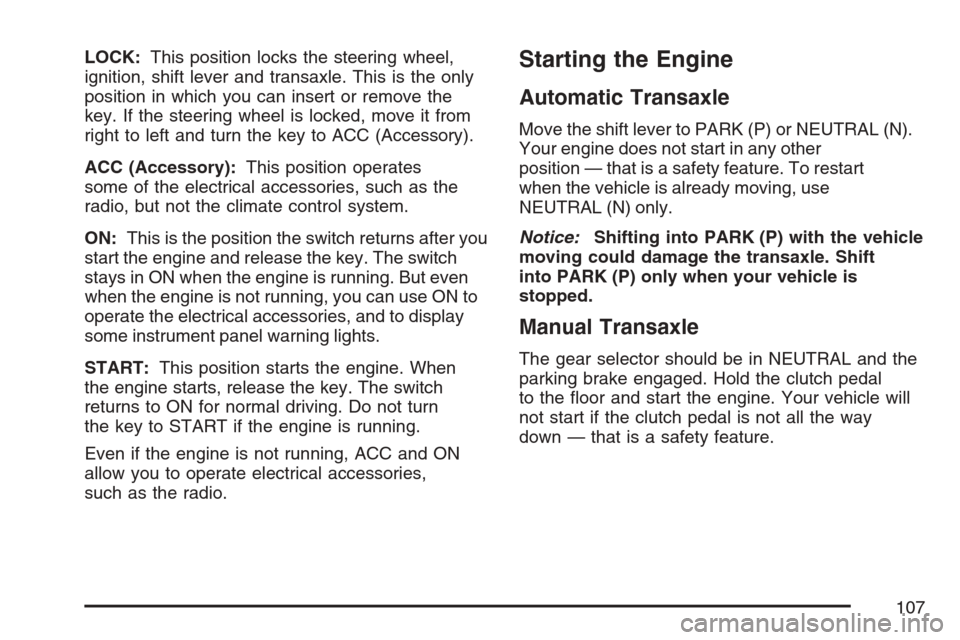
LOCK:This position locks the steering wheel,
ignition, shift lever and transaxle. This is the only
position in which you can insert or remove the
key. If the steering wheel is locked, move it from
right to left and turn the key to ACC (Accessory).
ACC (Accessory):This position operates
some of the electrical accessories, such as the
radio, but not the climate control system.
ON:This is the position the switch returns after you
start the engine and release the key. The switch
stays in ON when the engine is running. But even
when the engine is not running, you can use ON to
operate the electrical accessories, and to display
some instrument panel warning lights.
START:This position starts the engine. When
the engine starts, release the key. The switch
returns to ON for normal driving. Do not turn
the key to START if the engine is running.
Even if the engine is not running, ACC and ON
allow you to operate electrical accessories,
such as the radio.Starting the Engine
Automatic Transaxle
Move the shift lever to PARK (P) or NEUTRAL (N).
Your engine does not start in any other
position — that is a safety feature. To restart
when the vehicle is already moving, use
NEUTRAL (N) only.
Notice:Shifting into PARK (P) with the vehicle
moving could damage the transaxle. Shift
into PARK (P) only when your vehicle is
stopped.
Manual Transaxle
The gear selector should be in NEUTRAL and the
parking brake engaged. Hold the clutch pedal
to the floor and start the engine. Your vehicle will
not start if the clutch pedal is not all the way
down — that is a safety feature.
107
Page 110 of 422
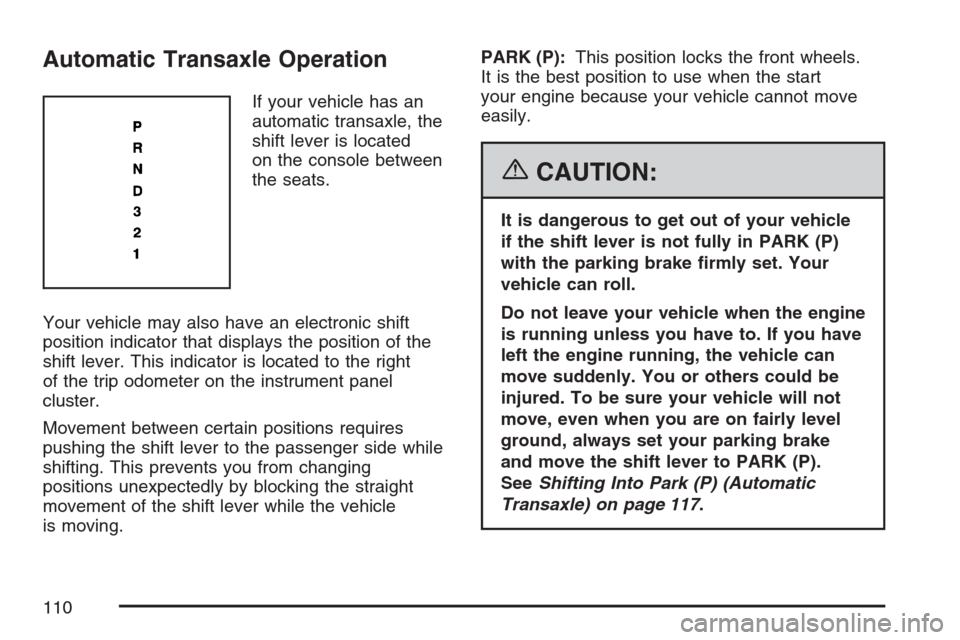
Automatic Transaxle Operation
If your vehicle has an
automatic transaxle, the
shift lever is located
on the console between
the seats.
Your vehicle may also have an electronic shift
position indicator that displays the position of the
shift lever. This indicator is located to the right
of the trip odometer on the instrument panel
cluster.
Movement between certain positions requires
pushing the shift lever to the passenger side while
shifting. This prevents you from changing
positions unexpectedly by blocking the straight
movement of the shift lever while the vehicle
is moving.PARK (P):This position locks the front wheels.
It is the best position to use when the start
your engine because your vehicle cannot move
easily.
{CAUTION:
It is dangerous to get out of your vehicle
if the shift lever is not fully in PARK (P)
with the parking brake �rmly set. Your
vehicle can roll.
Do not leave your vehicle when the engine
is running unless you have to. If you have
left the engine running, the vehicle can
move suddenly. You or others could be
injured. To be sure your vehicle will not
move, even when you are on fairly level
ground, always set your parking brake
and move the shift lever to PARK (P).
SeeShifting Into Park (P) (Automatic
Transaxle) on page 117.
110
Page 112 of 422
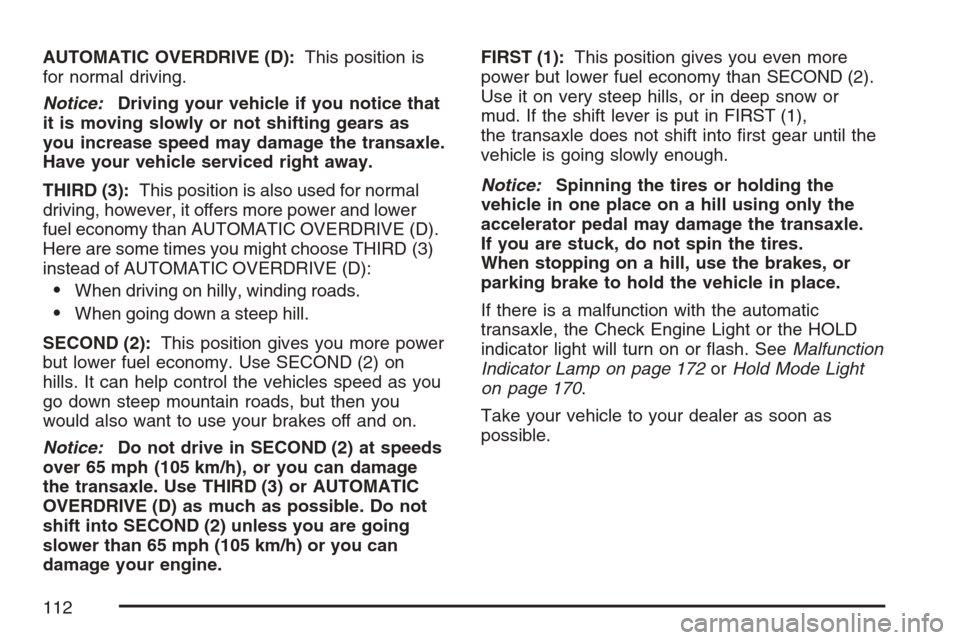
AUTOMATIC OVERDRIVE (D):This position is
for normal driving.
Notice:Driving your vehicle if you notice that
it is moving slowly or not shifting gears as
you increase speed may damage the transaxle.
Have your vehicle serviced right away.
THIRD (3):This position is also used for normal
driving, however, it offers more power and lower
fuel economy than AUTOMATIC OVERDRIVE (D).
Here are some times you might choose THIRD (3)
instead of AUTOMATIC OVERDRIVE (D):
•When driving on hilly, winding roads.
•When going down a steep hill.
SECOND (2):This position gives you more power
but lower fuel economy. Use SECOND (2) on
hills. It can help control the vehicles speed as you
go down steep mountain roads, but then you
would also want to use your brakes off and on.
Notice:Do not drive in SECOND (2) at speeds
over 65 mph (105 km/h), or you can damage
the transaxle. Use THIRD (3) or AUTOMATIC
OVERDRIVE (D) as much as possible. Do not
shift into SECOND (2) unless you are going
slower than 65 mph (105 km/h) or you can
damage your engine.FIRST (1):This position gives you even more
power but lower fuel economy than SECOND (2).
Use it on very steep hills, or in deep snow or
mud. If the shift lever is put in FIRST (1),
the transaxle does not shift into first gear until the
vehicle is going slowly enough.
Notice:Spinning the tires or holding the
vehicle in one place on a hill using only the
accelerator pedal may damage the transaxle.
If you are stuck, do not spin the tires.
When stopping on a hill, use the brakes, or
parking brake to hold the vehicle in place.
If there is a malfunction with the automatic
transaxle, the Check Engine Light or the HOLD
indicator light will turn on or flash. SeeMalfunction
Indicator Lamp on page 172orHold Mode Light
on page 170.
Take your vehicle to your dealer as soon as
possible.
112
Page 115 of 422
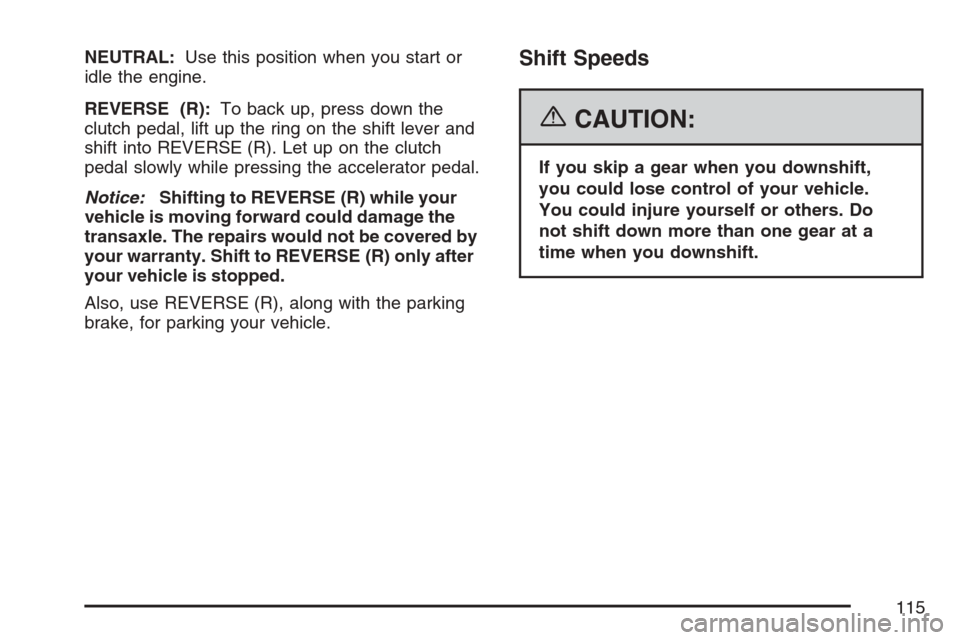
NEUTRAL:Use this position when you start or
idle the engine.
REVERSE (R):To back up, press down the
clutch pedal, lift up the ring on the shift lever and
shift into REVERSE (R). Let up on the clutch
pedal slowly while pressing the accelerator pedal.
Notice:Shifting to REVERSE (R) while your
vehicle is moving forward could damage the
transaxle. The repairs would not be covered by
your warranty. Shift to REVERSE (R) only after
your vehicle is stopped.
Also, use REVERSE (R), along with the parking
brake, for parking your vehicle.Shift Speeds
{CAUTION:
If you skip a gear when you downshift,
you could lose control of your vehicle.
You could injure yourself or others. Do
not shift down more than one gear at a
time when you downshift.
115
Page 116 of 422
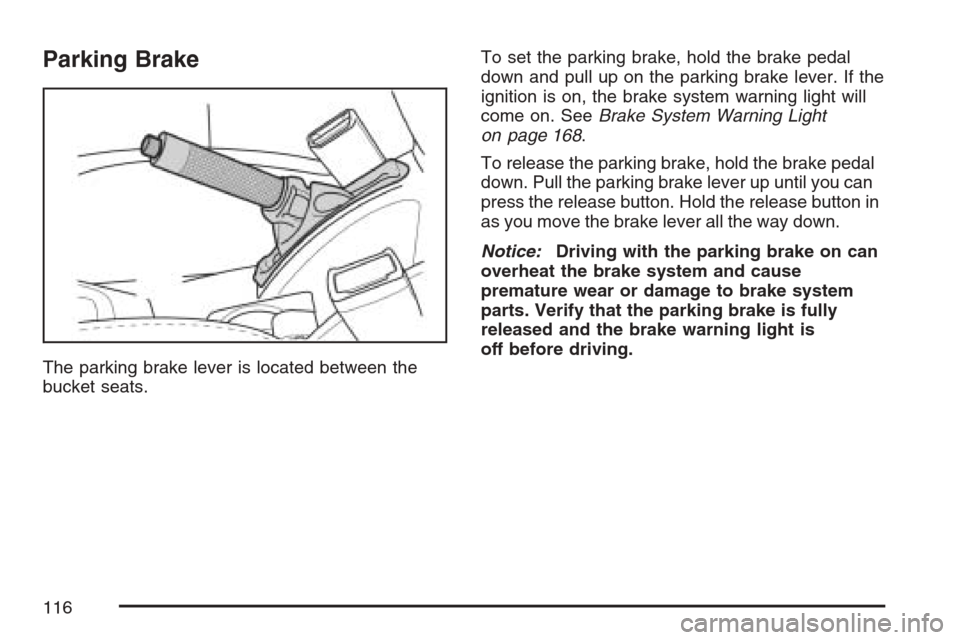
Parking Brake
The parking brake lever is located between the
bucket seats.To set the parking brake, hold the brake pedal
down and pull up on the parking brake lever. If the
ignition is on, the brake system warning light will
come on. SeeBrake System Warning Light
on page 168.
To release the parking brake, hold the brake pedal
down. Pull the parking brake lever up until you can
press the release button. Hold the release button in
as you move the brake lever all the way down.
Notice:Driving with the parking brake on can
overheat the brake system and cause
premature wear or damage to brake system
parts. Verify that the parking brake is fully
released and the brake warning light is
off before driving.
116
Page 117 of 422
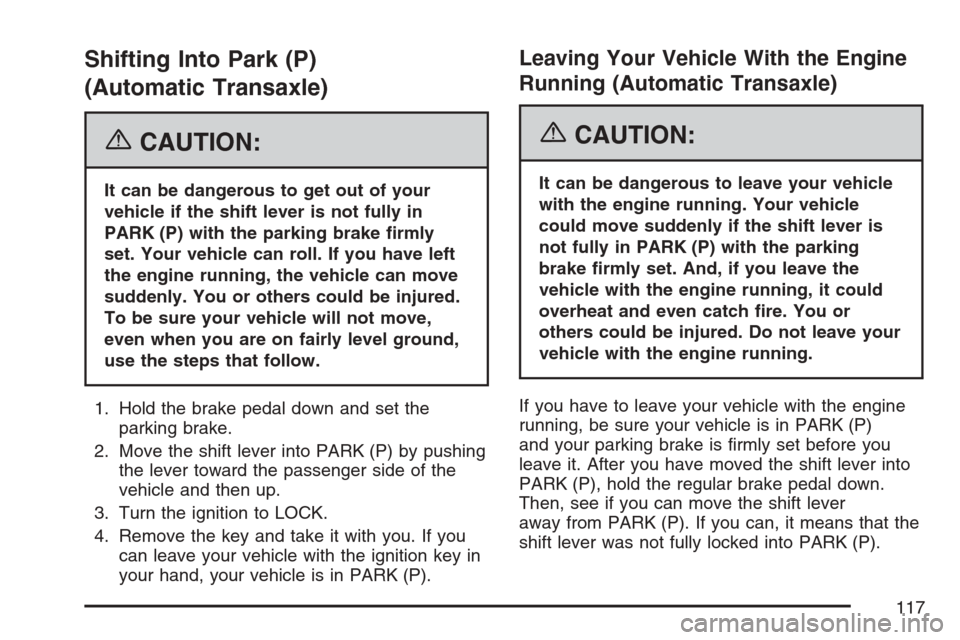
Shifting Into Park (P)
(Automatic Transaxle)
{CAUTION:
It can be dangerous to get out of your
vehicle if the shift lever is not fully in
PARK (P) with the parking brake �rmly
set. Your vehicle can roll. If you have left
the engine running, the vehicle can move
suddenly. You or others could be injured.
To be sure your vehicle will not move,
even when you are on fairly level ground,
use the steps that follow.
1. Hold the brake pedal down and set the
parking brake.
2. Move the shift lever into PARK (P) by pushing
the lever toward the passenger side of the
vehicle and then up.
3. Turn the ignition to LOCK.
4. Remove the key and take it with you. If you
can leave your vehicle with the ignition key in
your hand, your vehicle is in PARK (P).
Leaving Your Vehicle With the Engine
Running (Automatic Transaxle)
{CAUTION:
It can be dangerous to leave your vehicle
with the engine running. Your vehicle
could move suddenly if the shift lever is
not fully in PARK (P) with the parking
brake �rmly set. And, if you leave the
vehicle with the engine running, it could
overheat and even catch �re. You or
others could be injured. Do not leave your
vehicle with the engine running.
If you have to leave your vehicle with the engine
running, be sure your vehicle is in PARK (P)
and your parking brake is firmly set before you
leave it. After you have moved the shift lever into
PARK (P), hold the regular brake pedal down.
Then, see if you can move the shift lever
away from PARK (P). If you can, it means that the
shift lever was not fully locked into PARK (P).
117
Page 118 of 422
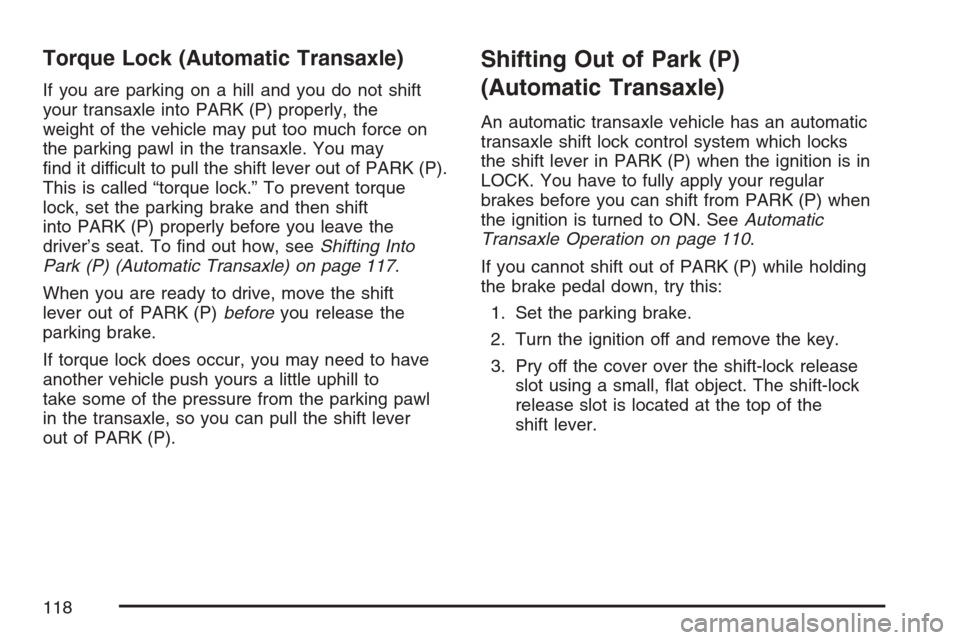
Torque Lock (Automatic Transaxle)
If you are parking on a hill and you do not shift
your transaxle into PARK (P) properly, the
weight of the vehicle may put too much force on
the parking pawl in the transaxle. You may
find it difficult to pull the shift lever out of PARK (P).
This is called “torque lock.” To prevent torque
lock, set the parking brake and then shift
into PARK (P) properly before you leave the
driver’s seat. To find out how, seeShifting Into
Park (P) (Automatic Transaxle) on page 117.
When you are ready to drive, move the shift
lever out of PARK (P)beforeyou release the
parking brake.
If torque lock does occur, you may need to have
another vehicle push yours a little uphill to
take some of the pressure from the parking pawl
in the transaxle, so you can pull the shift lever
out of PARK (P).
Shifting Out of Park (P)
(Automatic Transaxle)
An automatic transaxle vehicle has an automatic
transaxle shift lock control system which locks
the shift lever in PARK (P) when the ignition is in
LOCK. You have to fully apply your regular
brakes before you can shift from PARK (P) when
the ignition is turned to ON. SeeAutomatic
Transaxle Operation on page 110.
If you cannot shift out of PARK (P) while holding
the brake pedal down, try this:
1. Set the parking brake.
2. Turn the ignition off and remove the key.
3. Pry off the cover over the shift-lock release
slot using a small, flat object. The shift-lock
release slot is located at the top of the
shift lever.
118
Page 119 of 422
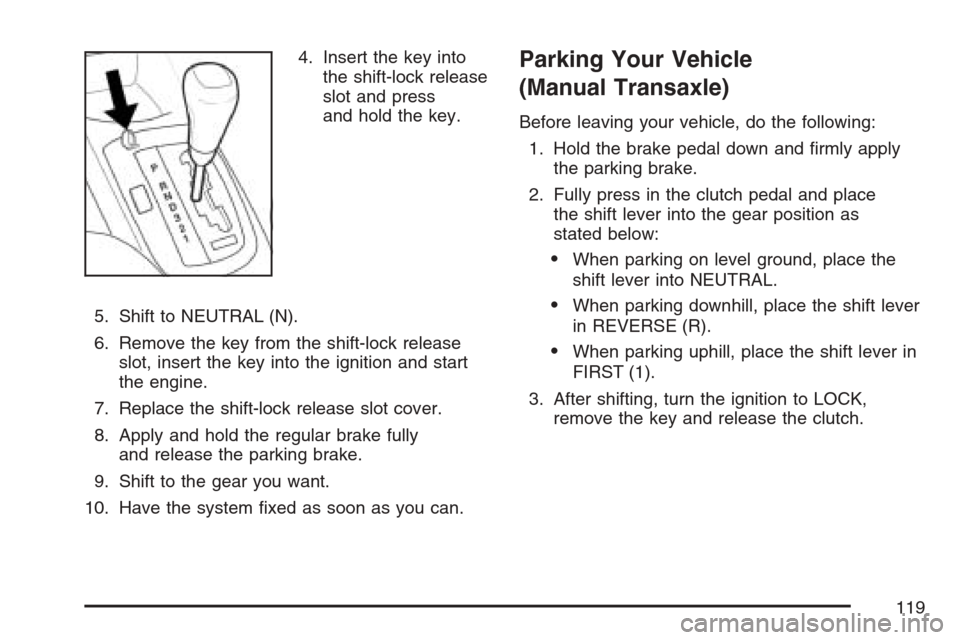
4. Insert the key into
the shift-lock release
slot and press
and hold the key.
5. Shift to NEUTRAL (N).
6. Remove the key from the shift-lock release
slot, insert the key into the ignition and start
the engine.
7. Replace the shift-lock release slot cover.
8. Apply and hold the regular brake fully
and release the parking brake.
9. Shift to the gear you want.
10. Have the system fixed as soon as you can.Parking Your Vehicle
(Manual Transaxle)
Before leaving your vehicle, do the following:
1. Hold the brake pedal down and firmly apply
the parking brake.
2. Fully press in the clutch pedal and place
the shift lever into the gear position as
stated below:
•When parking on level ground, place the
shift lever into NEUTRAL.
•When parking downhill, place the shift lever
in REVERSE (R).
•When parking uphill, place the shift lever in
FIRST (1).
3. After shifting, turn the ignition to LOCK,
remove the key and release the clutch.
119
Page 122 of 422
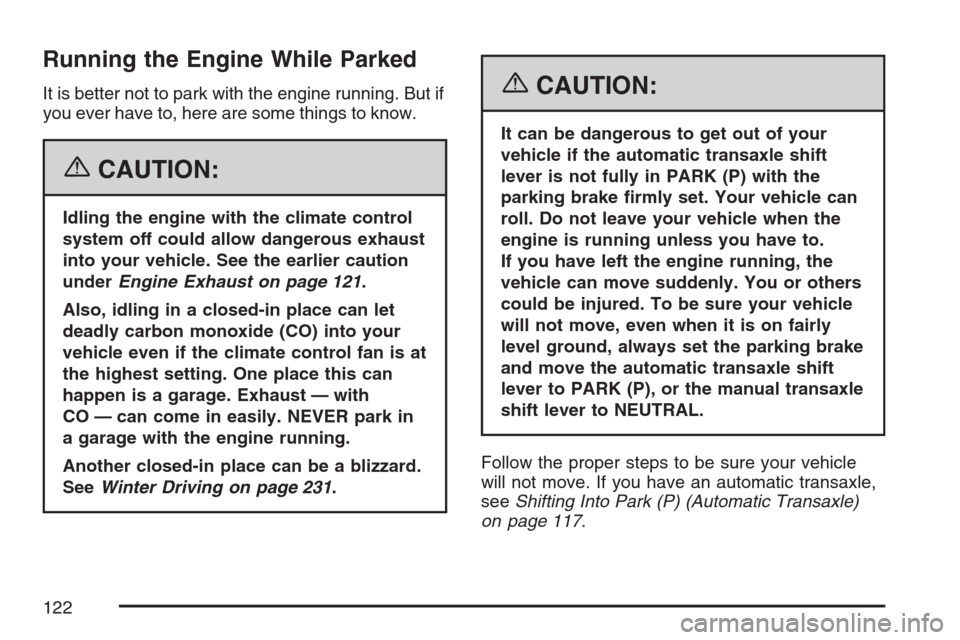
Running the Engine While Parked
It is better not to park with the engine running. But if
you ever have to, here are some things to know.
{CAUTION:
Idling the engine with the climate control
system off could allow dangerous exhaust
into your vehicle. See the earlier caution
underEngine Exhaust on page 121.
Also, idling in a closed-in place can let
deadly carbon monoxide (CO) into your
vehicle even if the climate control fan is at
the highest setting. One place this can
happen is a garage. Exhaust — with
CO — can come in easily. NEVER park in
a garage with the engine running.
Another closed-in place can be a blizzard.
SeeWinter Driving on page 231.
{CAUTION:
It can be dangerous to get out of your
vehicle if the automatic transaxle shift
lever is not fully in PARK (P) with the
parking brake �rmly set. Your vehicle can
roll. Do not leave your vehicle when the
engine is running unless you have to.
If you have left the engine running, the
vehicle can move suddenly. You or others
could be injured. To be sure your vehicle
will not move, even when it is on fairly
level ground, always set the parking brake
and move the automatic transaxle shift
lever to PARK (P), or the manual transaxle
shift lever to NEUTRAL.
Follow the proper steps to be sure your vehicle
will not move. If you have an automatic transaxle,
seeShifting Into Park (P) (Automatic Transaxle)
on page 117.
122